Sep 16, 2016 | advice, coins, commentary, shows
A reader who found the Coin Collectors Blog through a search came across the two-part series I wrote in 2012 about “How Are Coins Priced” (links to Part I and Part II). After asking a few questions this new reader asked me about the section about Negotiating in Part II.
My principles of negotiating are to be nice, do your homework, know when to stop and always be gracious. Although some of us consider negotiating a sport, there is no reason to be nasty. Always say “please” and “thank you” even if you did not buy the coin. Thank that dealer for taking the time to talk with you. Good will can go a long way!
As a new collector, this reader visited a few regional shows before going to the World’s Fair of Money. Thinking that as a big show there might be some good finds and can jumpstart an interesting collection. While this was not my reader’s first large show, it was the first time the family visited the World’s Fair of Money. It was also an excuse to go visit Mickey’s first theme park.
With his permission I am reprinting his note. I removed the section that described the dealer and his inventory:
My family and I went to Anaheim for the World’s Fair of Money. As we searched the tables looking for something of everyone’s interest we came across a table with books of coins. While I have seen notebooks like this with pages full of coins this was the first time we have seen so many. Each of us sat at the dealer’s table and started to look through the books.
My son is interested in Middle Eastern coins because my family emigrated from the Middle East after World War II. My daughter is fascinated by Queen Elizabeth and want to try to collect different coins with her picture. My wife’s family is from Japan and she has been picking up some older Japanese coins. As for me, I decided to try to complete a set of quarters after collecting the states quarters.
We are collectors. We are not putting the kids in front of the books to keep them occupied. At one point my son, who is trying to learn Arabic, was asking me what a few coins said and picked out a small handful for his collection. Nobody else found anything they liked.
We finished five minutes later and went to pay. My son has his own money and asked the dealer for the price. If we go by the numbers written on the coins, the price was $42. While that does not sound like much it is for a kid whose job is to cut grass and do odd jobs around the neighborhood. No discount was offered.
Standing next to my son I asked if he could do better on the price and that’s where the trouble began. He turned to me and said, “For what, hogging my table?” I was taken aback! Not only were we really looking to buy but my son was buying. As a matter of fact when my wife did not see anything she like she gave up her chair to another collector passing by.
I sort of stammered something about that we are all collectors and were looking but did not find anything and he said, then he said something like, “Then you should have gone somewhere else!” He was very rough.
I asked my son what he wanted to do. It was his collection and his money. With nobody else around this dealer’s table he blurts out, “yeah, kid, I don’t have time for this. Give me 40 and go away.”
I could see that my son was conflicted. While he wanted the coins he did not like the dealer. He then dropped his head and said in a soft voice, “No Thank you.” Although he looked like he wanted to cry the dealer responded, “great, now I have to figure out what book to put these coins in.” My son reached over and tapped the book and walked away.
I have never been embarrassed for my son like this. Why would a dealer treat a child or a customer like this?
I had no answers for these parents. Even though I do not deal with coins, when I do shows I try to treat everyone with courtesy, even when I can tell they have no intention of buying from my inventory.
When I am working shows, as I will be this weekend, days can be long and difficult. You have to be attentive to everything around you not just to complete the sale but to also prevent theft. Even on the slowest day, it does not pay to get nasty with a customer or potential customer.
This is not the first time I have heard stories like this and based on this reader’s description, it is not the first time I have heard this type of story about the dealer. I know for some it is just a job and like many jobs, after a while there are aspects that can be frustrating.
But this is a job that is about customer service for a product people do not have to buy. Coin collecting is a luxury, not a necessity. Even if you are frustrated, showing it to customers will give you a reputation and hurt business. Then what will you do when the customers do not show up?
There comes a point in time when you have to ask yourself whether it is worth the investment in time, money, and your sanity to continue or would it be better to just retire? Unfortunately, when it comes to some of the very long-time numismatic dealers who attend some of these major shows, there are too many that should consider retirement.
Jun 6, 2016 | advice, coins, counterfeit, currency, education, grading
This is final part of a 6 part series
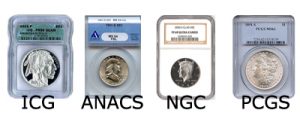 If you are uncomfortable trying to detect whether a coin is counterfeit or not, you might first consider buying from a reputable dealer who has return and/or buy back policies. If you buy raw coins and have questions, ask that the coin be examined by a third-party grading service such as Numismatic Guarantee Corporation, Professional Coin Grading Service, ANACSand Independent Coin Graders. These third-party grading services have a buy-back guarantee so that if the coin is ever found to be counterfeit after it was certified they will buy the coin from you at the price you paid. You may be asked to pay the grading fees. Some dealers may charge a service fee for submitting coins to the grading services on your behalf.
If you are uncomfortable trying to detect whether a coin is counterfeit or not, you might first consider buying from a reputable dealer who has return and/or buy back policies. If you buy raw coins and have questions, ask that the coin be examined by a third-party grading service such as Numismatic Guarantee Corporation, Professional Coin Grading Service, ANACSand Independent Coin Graders. These third-party grading services have a buy-back guarantee so that if the coin is ever found to be counterfeit after it was certified they will buy the coin from you at the price you paid. You may be asked to pay the grading fees. Some dealers may charge a service fee for submitting coins to the grading services on your behalf.
If you own coins that you may have questions about, either bring it to a dealer for an opinion or submit the coin to the third-party grading service yourself. NGC and PCGS have membership services that allow you to directly submit coins for authentication and grading. Members of the American Numismatic Association can register to directly submit coins to NGC. ANACS and ICG allows for collectors to directly submit coins for authentication and grading.

Sample of a PMG Holder

Sample of a PCGS Currency Holder
If you are buying through an online auction and you have any question about the coin, you are better off not trying to purchase it than trying to deal with returns. While there are quite a few reputable dealers who sell on these sites, it may take more than a month for the process from purchase to refund to occur. During that time, you will not have access to this money.
Remember, caveat emptor, “let the buyer beware.” Without a warranty or some type of assurance, such as a graded and encapsulated coin, the buyer takes all of the risk.
For sellers, caveat venditor, “let the seller beware.” Unless you expressly disclaim any responsibility, you will be held liable if the item is not true to its specification. You may also lose a future customer if that person feels cheated.
The Hobby Protection Act
Over the last number of years, we have seen when a hobby becomes popular and items increase in value, there are opportunists who will try to do whatever it takes to make money from the gullible and uneducated. This chapter was written to inform and educate you as to what to expect from those looking at your wallet and not to you as a valued customer so that you are not a victim.
When I discuss these issues I am eventually asked, “Aren’t we protected by the Hobby Protection Act?” In short, the answer is yes and no. The Hobby Protection Act of 1973 and was amended in 1988 represents an attempt at stopping counterfeits in all collectibles based on the way the world worked in 1973 and slightly updated in 1988. A lot has changed since then including the technologies available to counterfeiters.
The Hobby Protection Act requires that coins not made by the U.S. Mint include the word “COPY” somewhere on the surface. The law allowed law enforcement and buyers to go after the suppliers. The problem was that the suppliers were mainly in China and out of the reach of the U.S. criminal justice system. That changed in December 2014 when congress passed and the president signed the Collectible Coin Protection Act (Public Law No. 113-288). Under the new law, consumers and law enforcement can take civil action against the distributors and resellers of counterfeit coins.
The Federal Trade Commission has published draft rules to update the wa they enforce the (16 CFR Part 304) made by the passage of the Collectible Coin Protection Act.
FTC is required to publish the new rule in the Federal Register (81 FR 23219) and ask for public input on the new rules. These rules are the result of corrections made after a previous draft asked for comments on the costs, benefits, and overall impact of the rules.
Comments can be made on the FTC’s website or via postal mail as outlined on the website and in the Federal register.
Even though the law has changed, you should educate yourself and work with reputable people to build your collection. Education can be fun and the knowledge will help you better enjoy the hobby!
Credits
- Certified coins images courtesy of Dakota Coin.
- Image of the PMG holder courtesy of Paper Money Guarantee.
- Image of the PCGS Currency holder courtesy of PCGS Currency.
May 24, 2016 | advice, coins, education
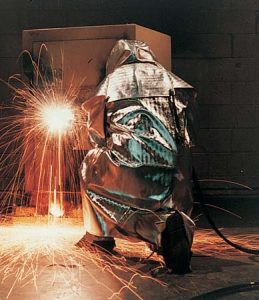 Those who follow my Twitter feed (@coinsblog) will notice that I have been posting links to stories about how the current Libyan government is trying to break into the vault once controlled by Muammar Gaddafi. The vault is supposed to have gold and silver coins estimated at $184 million. Libya is desperate to access this cache that the central bank hired professional safecrackers to open the vault.
Those who follow my Twitter feed (@coinsblog) will notice that I have been posting links to stories about how the current Libyan government is trying to break into the vault once controlled by Muammar Gaddafi. The vault is supposed to have gold and silver coins estimated at $184 million. Libya is desperate to access this cache that the central bank hired professional safecrackers to open the vault.
We can learn a lesson from this story. Aside from being someone that others want to terminate with extreme prejudice, what will happen with your collection and other protected collectibles should something happen to you?
Do you have a safe deposit box or a safe in your house where you keep your collection? What is your plan should something happen? You don’t have to be of the Baby Boomer generation to worry about what would happen. Even before I was eligible to be a member of AARP, I would ask what their contingency was if I was hit by the proverbial cross-town bus?
Even though the response was a nervous laugh and an exclamation that a lot of institutional knowledge would be lost if I was hit by a bus, the fact remains that even though I am healthy I cannot predict what could happen.
What would happen at home if something would happen to me? When considering both my electronic life and my collection, I had to think about how to tell my survivors what to do with everything. Electronically, I have a contingency plan that would allow my survivors to access files, websites, and other assets. For my collection, I have it documented and instructions as to what to do.
Although you would like to live on or help your survivors, the fact remains that not only do they not have your interests but will not know what to do with that album of Morgan dollars you spent years collecting.
There are so many consideration that you may want to consult one of the books on the market about selling a coin collection. While the books were written to guide those who inherit coin collections, it will give those planning for their estate what your heirs will have to deal with when the time times.
The two books you should read are:
Failure to plan is a plan to fail. Give your heirs a break and come up with a plan that they can follow to take care of your collection when you cannot.
Apr 30, 2016 | advice, coins, currency, supplies
A reader with questions recently reminded me of a previous version of this article. After reading what I wrote, I noticed a few things that required editing along with some additional information I could add. Rather than keep this to myself, I am sharing so that it can also serve as a reminder to everyone about proper storage.
After putting in the time, effort, and resources to assemble your collection do not just throw it in a draw or closet. Coins, currency, tokens and medals can become damaged if not stored properly. It would be a shame if your collection is damaged when a little effort can keep your collection preserved.
Storing a collection is a matter of dealing with two factors: using archival safe storage materials and the environmental factors of where your collection is stored.
Archival Safety
 All coins, medals, tokens, and currency are made from materials that will react with the environment. Metals will oxidize and tone, some with patterns that intrigue collectors. Paper-based materials can be made from cotton rag or linen that may not break down the same way as paper but can be damaged in a way that will affect its value. The key to storing your collection is to use products made from archival safe materials. Archival safe materials are those made that are not acidic, materials that do not turn acidic over time, or materials that are not too alkaline.
All coins, medals, tokens, and currency are made from materials that will react with the environment. Metals will oxidize and tone, some with patterns that intrigue collectors. Paper-based materials can be made from cotton rag or linen that may not break down the same way as paper but can be damaged in a way that will affect its value. The key to storing your collection is to use products made from archival safe materials. Archival safe materials are those made that are not acidic, materials that do not turn acidic over time, or materials that are not too alkaline.
Acid free means that the pH (potential Hydrogen) measure is 7.0 or less. A pH measure of 7.0 is neutral and greater than 7.0 is basic or alkaline. Although acidic materials will damage your collection, materials too alkaline will also cause damage. Those that produce acid free supplies with materials that is as close to being pH neutral as possible.
It is possible for some materials to be acid free without being archival safe. These are substances that can breakdown over time and become acidic. For example, commercially made paper contains lignin, a bonding elements that naturally occurs in the pulp that helps holds the wood fibers together. While lignin is not acidic it gives offs acids as it deteriorates. To prevent lignin from becoming acidic it must be treated. This treatment involves dipping the paper in a solution that neutralizes the natural lignin.
Another storage item to stay away from are plastic products made from polyvinyl chloride (PVC). PVC is a inexpensive plastic that is used as an additive to other plastics to make softer, more flexible products. One example of a numismatic product that can be made using PVC are the two-pouch coin holders called flips where each pouch is 2-inches square. PVC in itself is neutral but gives off an acidic gas in reaction to atmospheric conditions. The PVC gas will not only react with the coins but will deteriorate the plastic. The result will be a green or gray streaks or blob appearing on the coins.
The gas produced by deteriorating PVC will damage the surface of the coin. Once a coin is damage by PVC it cannot be reversed. There are ways to conserve coins that are damaged by PVC as long as the PVC contamination is discovered early and is only on the surface. Once it mars the surface, the coin is permanently damaged and its value diminished.
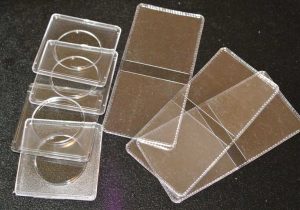
Archival Safe Flips and Cases
Some people like to buy older albums because of they are unique and have a classic look. Those albums may not be made of archival material including paper with active acid from the deteriorating lignin that was not neutralized during manufacture because this was not a concern. Also, cover sliders could be made of PVC or other plastics that are not neutral. If you are not sure whether that used album is safe, it is best to buy a new archival safe album.
Although this discussion centered on coins, the same can be said for currency storage. The only difference will be the size and types of holders.
Environmental Factors
You can use the most archival safe materials but they will not protect your collection from environmental factors. The general rule of thumb is to stay away from the extremes. Do not store your collecting in a place that is too hot or too cold. Try not to store your collection in a place that is too humid or too dry since both could cause your storage materials to react. In other words, the average home with a temperature of 64-78 degrees with an average humidity of 30-percent should not be a problem.
Those living in colder areas where the home heater is being used longer than other areas of the country may have to compensate. Forced air heating systems tend to dry the air that could cause damage to your collection. If you use a humidifier, whether built in to your heating system or a standalone unit, you might consider investing in a hygrometer to keep the relative humidity between 30 and 40-percent.
Where you store your collection also has to be a concern. If you keep your coins in a cabinet, the gasses from the wood and even the paint or stain can cause damage. While wooden cabinets are attractive and practical, you do not want to store your collection some place that could add to the environmental concerns.
Metal cabinets are a better option. Safes and safety deposit boxes in temperature controlled vaults also makes great storage options aside from being able to keep your collection secure.
One of the factors that could cause wood rot in cabinets is excess humidity. If the humidity in your home or where you store your collection cannot be controlled, you should use a desiccant. A desiccant is a substance able to absorb moisture in the air. Two common desiccants are silica gel, the little packets that you see in some packaging, and montmorillonite clay.
Choosing which desiccant to use depends on your situation. If your storage area is not that humid, use silica gel. It well suited for lower moisture area over a longer period of time, about six months. For high humidity areas, use a clay desiccant. Although it will not last as long as silica gel (about three months), clay is more effective at removing moisture where the humidity is higher. Another option is to use a combination, especially during seasons of high humidity. You can purchase silica gel and clay desiccants at many hobby stores and stores that sell collecting supplies.
While there are other types of desiccants, they are not recommended for use around collectibles. Calcium sulfate and calcium chloride uses sulfur and chlorine, both will not react well with the metals of your coins. Activated charcoal can add carbon dust to the air, which can attach itself to your coins. Some have suggested using salt as a desiccant. Salt is made of sodium chloride that would also introduce metal damaging chlorine into the environment.
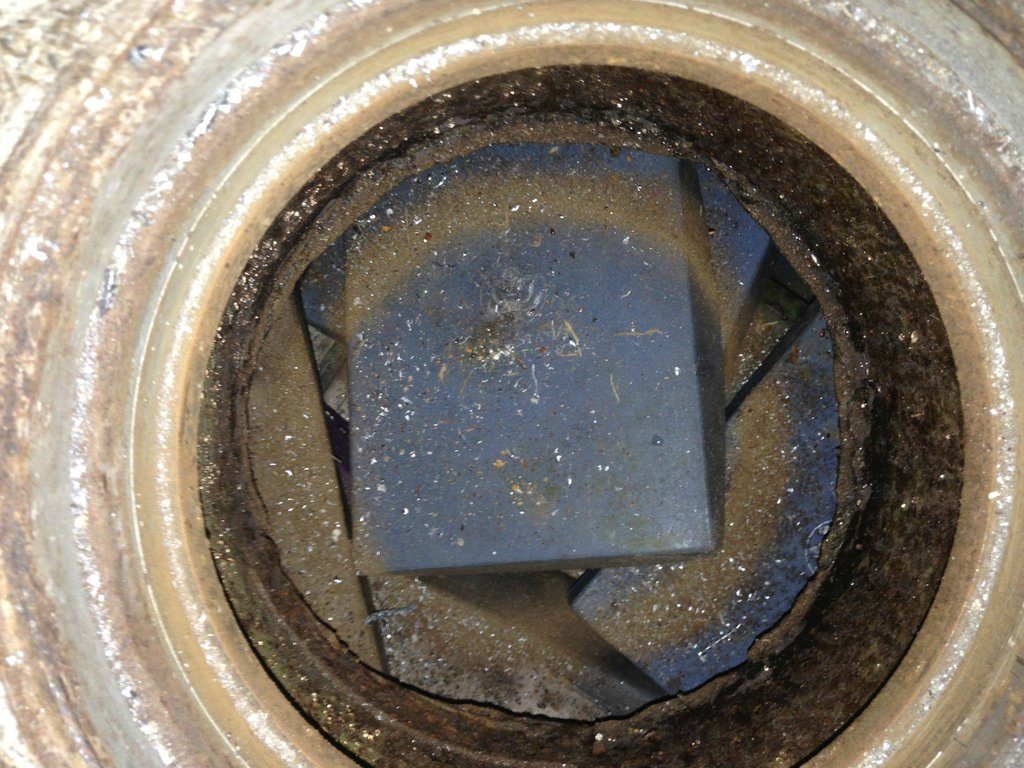
Not all safes are safe for coin storage. Click on the image to read the story about a safe found in the house of the writer’s late grandfather.
Choosing Storage Products
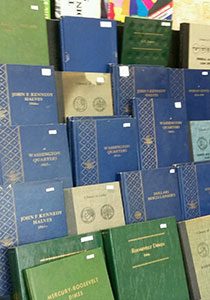
Be careful, old coin albums may not be archival safe!
Albums are popular for raw coins collected in the published series. You can find albums for many series from different manufactures to suit your tastes. Each manufacturer has its own distinct color and style. The difference is your personal preference.
Coins that have been encapsulated by third-party grading services may present different issues for storage and display. While there are a few manufacturers that make a special page to fit the grading service’s holders, collections made up of coins encapsulated by different grading services can be stored in boxes.
When storing grading service holders it is important to remember that the holders are not considered airtight. Third party grading services uses sound waves to melt the halves of the plastic holder to bond them without using chemical adhesives. While this type of sonic seal is strong, it can be subject to breaking if the encapsulated coin is mishandled. Additionally, whatever contaminants were in the air around the time the slab was sealed would be trapped with the coin.
Although most encapsulated coins could be stored in a standard plastic case, those who want extra protection should consider storing the slabs in special archival quality inserts or polyethylene bags.
When storing your collection you can use the same archival quality containers that are used by organizations like the United States Archives or Library of Congress. Although many of the containers may be coated with an alkaline buffer should not be a deterrent. Since your coins are in another holder, whether encapsulated or within an album, the buffer will maintain a barrier between your collection and the storage box that should not hurt your coins.
Although proper storage of your prized collection is important, do not make it more important than your collection. Be careful how you store these items but do so in a way you can still enjoy what you collected.
Image Credits (in order of appearance)
Apr 23, 2016 | advice, coins, commentary, legal
If you have not visited Etsy, you will find a shopping site where you can find unique items that are not available elsewhere. Most of the sellers on Etsy sell handmade designs, vintage items, repurposed vintage items, supplies, and unique low volume goods. It would not be farfetched to call Etsy an Internet craft fair and a neat place to go shopping.
One of the more interesting items on Etsy are coin jewelry. Coin designs are themselves a form of art but can become ordinary when repeated over millions of coins. Take a meaningful design and add it to a bezel, attach it to a pendant, or hammer it into a ring and these artists take the coins to the next level.
Many of these artists will take requests for the type of coin for their creations. Some will even let you send a special coin or a coin they cannot obtain to create your design.
A quick search on Etsy for coin jewelry found over 100,000 different jewelry items including bracelets, rings, earrings, bracelets and more. Aside from the different types of jewelry the artists will also use coins from all around the world including the United States, United Kingdom, Canada, Norway, and more.
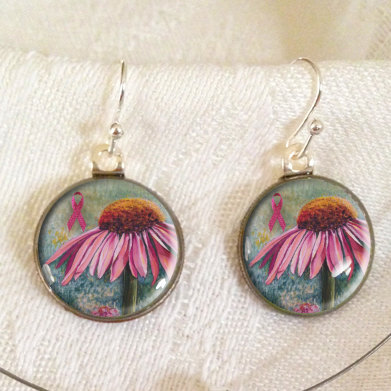
Resin ear rings made by InspiringFlowers using Roosevelt dimes

1996 Half Dollar Ring by LuckyLiberty

Hummingbird cut from a Trinidad and Tobago penny by SawArtist
Click on the image to visit artist’s store
Coin jewelry hunters may be unknowingly accessories to a crime. According to an article in The Straits Times, it is illegal to make jewelry using coins from Singapore.
Like many other nations, Singapore takes pride in the art on their coinage. Aside from being their means to promote commerce, they are used to represent their culture and society. However, the Monetary Authority of Singapore (MAS), the Singapore equivalent of the U.S. Treasury Department, has said that under Singapore’s Currency Act, it is illegal to “mutilate, destroy or deface” their money. Offenders can be fined up to $2,000.
If you search for “Singapore coin jewellery” (the British spelling of “jewelry”) on Etsy, you will find around 200 different jewelry items returned as part of the search. It is common to see Singapore flower series coin or older coins that featured seahorses.
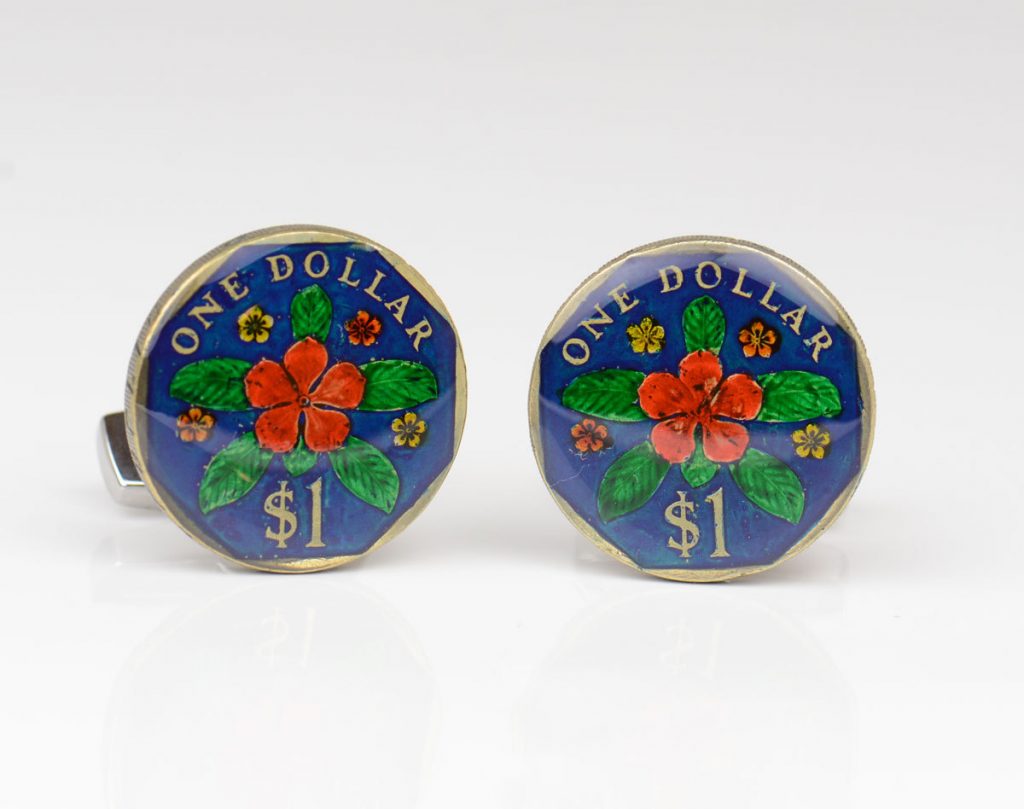
Painted Singapore Dollar coin ring by Monedus
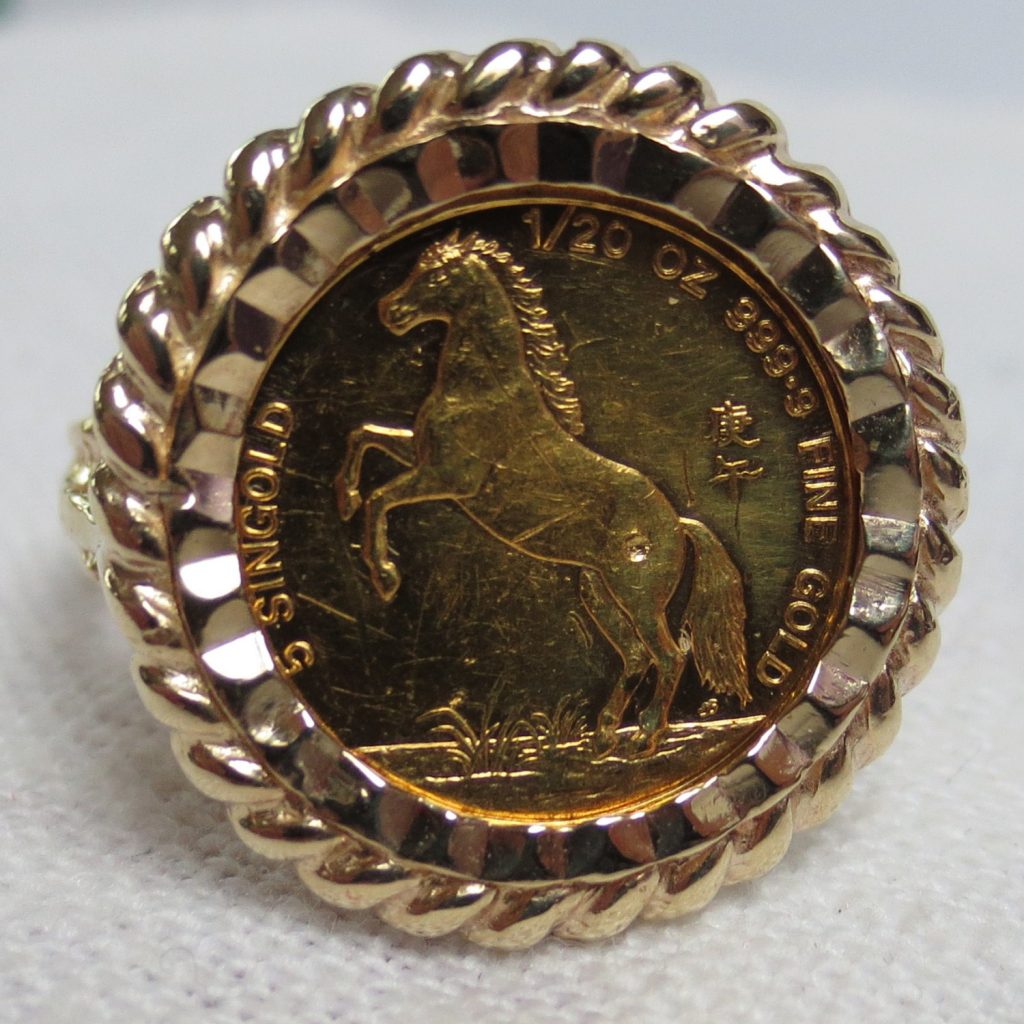
1990 Singapore Horse bullion coin 1/20 oz. in a ring by BritanniaJewelry

Pendant made using a cutout 1979 Singapore coin
Click on the image to visit artist’s store
None of these artists are based on Singapore
While United States law allows for people to use coins for jewelry or other purposes as long as there is no attempt to use them as legal tender currency (18 U.S.C. § 331), this might not be the same for other countries. Although European laws are similar to those in the United States, there is some question as to whether the laws of Canada and Australia can be interpreted to have the same restrictions as Singapore.
When I asked an attorney, he questioned whether an international buyer would convicted of a crime. We both agreed that if you buy jewelry with an international coin, leave it home if you plan to visit that country.
Etsy was asked for a comment but attempts to contact them via email has not been answered.
All images are courtesy of their respective artists on Etsy.
Nov 18, 2014 | advice, auction, cents, coins
 Over the weekend I attended an estate auction that included coins for sale. While my new business venture concentrates on all vintage collectibles, I am still a collector and continue to look for those interesting items and the good coins to add to my collection. As I was looking over the lots I noticed one had several blue folders of Lincoln cents. The collector in me could not resist and I picked up the folders and started looking.
Over the weekend I attended an estate auction that included coins for sale. While my new business venture concentrates on all vintage collectibles, I am still a collector and continue to look for those interesting items and the good coins to add to my collection. As I was looking over the lots I noticed one had several blue folders of Lincoln cents. The collector in me could not resist and I picked up the folders and started looking.
Every hold was filled.
What drew my eye first was the hole marked “1909-S VDB.” Even though the 1914-D may be worth more, the 1909-S VDB is considered the Holy Grail amongst change hunters. With only 484,000 struck the odds of finding one are not in a change hunter’s favor. But we keep looking and hoping.
After reaching into my pocket for my ever present loupe, I asked the attendant if I could remove the coin to see the reverse. I had to check for those three letters on the back because it did say it was a 1909-S on the front. With the attendant watching me, I removed the coin from the slot, turned it over and brought it up to my loupe.
Using a 16X loupe I zeroed in on the area where I could find the “V.D.B” only to find something unexpected. On this coin, the “VDB” with no periods were punched into the coin. Holding the coin and turning it in the light to see how the light reacts, it was easy to see that the coin was not real.
Being very disappointed I quietly told the attendant that the coin was altered. She did not know what to do. When I suggested she tell her boss, she took the coin from me and went into a back room. A moment later, she returned and asked me to follow her to the office.
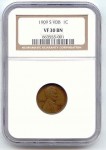
Scott’s 1909-S VDB
I understand how he felt. In the auction business, they earn money from the buyer and seller fees. If the item sells for a high price, the auction house makes more money. In this case, since the coin was a solid VF, it could have sold for $700-800 alone.
Before he became too angry, I asked to see the 1914-D. At VF that coin is about $400 in the retail market. When I looked carefully I could see that the mintmark was added to the coin. It was not a very good job when you see it under magnification but looked all right on first glance. I showed the auctioneer how I know it had the mintmark added. He agreed with my assessment.
He asked if there were any more important dates that he should know about. I zeroed in on the hole for the 1922-D that had “No D” written in pen under the date. Even before finding the date under the loupe I could tell the coin was whizzed. That is a bad sign to begin with but if the coin was real, it would diminish its value but not make it worthless. What made it worthless was that you can tell someone filed the mintmark off the coin. Whoever did the filing did not do a good job because it made a little hole where the mintmark should be. This coin doctor probably whizzed the coin in order to cover up the alterations.
To say I gave this gentleman a shock would be an understatement. He shook my hand and offered me a discount on the buyer’s fee for helping him. After leaving his office he had the attendant who helped me remove all of the blue binders from the auction. When I spoke with the attendant later, she said they were all from the same consignor and that he was going to return them as being unsalable.
This was not the first time I attended an auction at this place and it will not be my last. Aside from being able to purchase good inventory for my business, they have proven to me they have integrity. Knowing this helps me buy with confidence.
I tell this story to provide two lessons. First, always examine the items before you bid. Even for online auctions, examine the pictures and read any descriptions carefully. If you are afraid to buy ungraded coins, then buy only graded coins. But make sure you are fully aware of what is being sold. Do not be afraid of asking the seller a question or even asking for a better picture. If the seller cannot help you then do not buy from that seller.
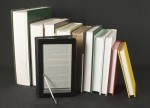
Buy the book before buying the coin!
My second lesson is to know who you are buying from. This is more difficult online but you do have to take the feedback seriously. Again, if you have any questions you should ask. Every site has a way to contact the seller in order for you to ask questions. If the seller is not cooperative, let that be a sign for you.
When working with auction houses, it takes a little longer to establish a relationship. But you need to introduce yourself, talk with people and ask questions. Make yourself known and show that you are a serious buyer. It may take a few auctions to establish a relationship, but be persistent. Aside from preferential treatment and discounted seller fees, someone with a relationship can be told bout unpublished items in advance so that you are prepared to buy quicker than someone off the street. Another advantage is that if you specialize in something that the auction house cannot sell, you can buy it as a good price. As a reseller, I find that very good for business.
Even though online auctions are very popular, there is nothing better than being there live. I highly recommend the experience.
Apr 26, 2014 | advice, education, security, technology, web
 The Royal Canadian Numismatic Association sent email to its members notifying them that on April 24 someone attempted a phishing scam trying to impersonate the RCNA Executive Secretary trolling for information. The RCNA did not send out an email note asking for information and recommended deleting them email.
The Royal Canadian Numismatic Association sent email to its members notifying them that on April 24 someone attempted a phishing scam trying to impersonate the RCNA Executive Secretary trolling for information. The RCNA did not send out an email note asking for information and recommended deleting them email.
Phishing is the term used to describe the attempt to convince someone to reveal personal information by sending them an email that looks like it came from a legitimate source. In this case, the attacker made their email look like it came from the RCNA hoping that members would give up their personal information.
When I am not blogging, meeting with other numismatists, or being with my family, I work in information security for the United States federal government. In my professional life, I have seen a lot of attempted and successful attacks against both government and commercial systems. However, the one attack that is the most difficult to defend are those where humans are convinced to act against their own best interest, such as a phishing attack.
Social engineering attacks are my favorite attacks. One reason is that it helps demonstrate to the organizations that I try to help that security is more than controls, encrypted communications, or anything else you might have read in the news. Security is a process that requires diligence, the same as it does in the real world.
The following are four rules that you can follow to help keep safe online:
Rule #1: Unless you are 100-percent certain that the email is legitimate, do not click on the link!
You will be never 100-percent certain that any email you receive is legitimate so make sure that you are as close as 100-percent certain as possible. One thing you can do is to move your pointer over the link, stop, and wait for the tooltip to show you the address.
Tooltips are those balloon-like popups that will tell you something about the link or element before you press the mouse button. One way to tell that a link is bad is that if the address is not what you think. For example, if the link is supposed to send you to the RCNA website, the tooltip better say that it will send you to rcna.ca. If it does not, then do not click on the link.
When you check the link, the address of the server is the first part of the address. If what should be the server name is not in that area at the beginning of the address, do not click on the link.
One trick the phishers use is to show you what looks like a complicated address in the message, but the link behind it will send you to another website. This is where tooltips can help. If you hover over the address and they do not match, it is an attempt to trick you and you should not click on the link.
If you are using a web-based email client, you can check the address on the status line at the bottom of your browser window. Check to see if the address makes sense is also a good tool. For example, if the link is supposed to be from the RCNA and “rcna.ca” is not the address of the server in the link, then it is a phishing attempt and you should not click on the link.
If you are unsure about the link, then go to your browser and type in the address yourself. Rather than clicking on a suspicious link, you can visit the RCNA website by typing “http://rcna.ca” directly into your browser’s address bar.

Anatomy of a Phishing email
(courtesy of the University of California-Davis)
Rule #2: No legitimate company or organization will send you a form to fill out and email back
One of the tactics that the phishers use to try to trick you into giving them your personal information is to create a form that looks like it is legitimate. Just as it is easy for someone with moderate skills to fake a web page, they can create a counterfeit form. Not only will the form be counterfeit, but they could also embed programs in that form to steal your information.
Embedded code in documents is called macros. Macros are used to command programs to do something for the user. When used in productive environment, macros can be a wonderful tool to create dynamic documents. But the same instructions that can make macros a productive tool can also be used to do bad things.
Unless you are certain about where the document came from, then do not open a document. If you open the document and the program asks if you should enable or run macros, do not enable macros.
This is not just a problem with word processing document. PDF documents can also deliver very nasty malware (malicious software). Not only can an attacker add macros to a PDF document, but someone can embed the technology called Flash in those PDF. Flash is the technology that helps you see videos and add enhancements to the visual interface of some websites. But Flash can be used to attack your computer system. Opening a PDF file sent by someone you do not know can be as dangerous as a word processing document.
Rule #3: Do not open suspicious attachments
Another trick the attackers try to use is adding an attachment named in a way to try to trick you into opening the file. File names consist of the name of a file followed by a period followed by a file extension. The file extension is used to tell the computer the type of program to open to allow you to work with the file. There are three file extension that very dangerous and should never be opened unless you are absolutely sure who sent them to you: .zip, .exe, and .dmg for Mac users.
The .zip file extension tells the computer that the file is something called a Zip archive. A Zip archive is a file that is formatted to allow it to store many files that are compressed. Zip files are used for many legitimate purposes including being the default format of Microsoft Word’s .docx file. Unfortunately, it can contain files that can be used to attack your system.
One of the types of file that can be included in a Zip archive is an .exe or executable file. Simply, these are programs in the same way that Microsoft Word is a program. Once an executable file is opened, it will do whatever it is programmed to do. Among the things that the program can do is key logging. A key logger reads what you type on your keyboard, what you click on the screen, and in some cases what is displayed on your screen. The key logger will be able to capture the user name and password you entered when you visit any website including your bank’s website. The problem is that when a key logging program is run, you do not know it is watching what you type. Nor do you know that it connects to a server somewhere on the Internet to send the information to the attacker.
While Macs are more difficult to attack, they are not immune. Mac users should never open a file with a .dmg file extension unless you know who sent the file. The Macintosh .dmg file is a disk image file. A disk image file is formatted to look and acts like a disk so that when you double click the file, it will mount on your computer as if you plugged in an external disk drive. Because .dmg files are commonly used to install legitimate software, sometimes the installation can be automatically started. If you allow the installation to continue, it you can install software as dangerous as what I described for the Windows .exe file.
Rule #4: When in doubt, throw it out!
 While all this seems simple to me, I have been in this industry for over 30 years and am used to the complication. The problem with email is that it was developed as a way for researched to communicate by plain text across the Arpanet, the forerunner of the Internet. Essentially, email is a text-based service that has been extended in so many ways that it has created a complicated series of standards that requires a degree in computer science to analyze.
While all this seems simple to me, I have been in this industry for over 30 years and am used to the complication. The problem with email is that it was developed as a way for researched to communicate by plain text across the Arpanet, the forerunner of the Internet. Essentially, email is a text-based service that has been extended in so many ways that it has created a complicated series of standards that requires a degree in computer science to analyze.
Even if you cannot fully analyze whether the message is spam or legitimate, if you have any doubt, then just press the delete button. If the message came from a source you know, contact them off line and ask if the mail is legitimate. If you think the email is from your bank, call the bank and ask. If you think the email is from your credit card company but not sure, call the credit card provider and ask. If you think the email sent from the RCNA is suspicious, call them and make and ask.
A little intuition can be of great help in these circumstances.
Stay safe online and have a good weekend!
Apr 11, 2014 | advice, coins, security, technology
 Computer and online security has been a topic for the news lately. This was because of a mistake made in software that was being used to try to keep your password from being seen by criminal hackers was making it visible to those criminals. In the wake of the news, the Doug Davis of the Numismatic Crime Information Center sent out a message to his list of contacts that had one central message for every dealer and collector:
Computer and online security has been a topic for the news lately. This was because of a mistake made in software that was being used to try to keep your password from being seen by criminal hackers was making it visible to those criminals. In the wake of the news, the Doug Davis of the Numismatic Crime Information Center sent out a message to his list of contacts that had one central message for every dealer and collector:
Shooting simple photos from your smart phone or personal camera can lead criminals right to your location… with pinpoint accuracy using GPS satellites.
You might have heard the term “metadata” in the news in the context of its collection by the National Security Agency. For those who do not know what metadata is, think of it as a description of the data. Think about an exhibit in a museum. The exhibit contains several artifacts arranged in a certain way to try to tell a story. But the story is incomplete because a little more information is needed to put it into context. But the information cannot be shown as an artifact in the exhibit, so the person setting up the exhibit adds a description added to the exhibit to make it more understandable. That description would be the metadata to the exhibit.

Example of what you can find out about your image in the file’s Properties under Windows
Modern cameras, cameras built into smartphones, and even some memory cards that can be inserted into older cameras can determine where you are located and record that in the metadata in the picture you take. And contrary to what you have read, new technologies do not have to use the Global Positioning System (GPS) to figure out where you are located. There are services that use WiFi to record your position. It is called WiFi Positioning System (WPS). Basically, WPS determines where it is located and communicates that to WiFi connected services so that it could be used to determine your location.
I know geotagging can be a lot of fun. A few years ago when my wife and I drove from Portland, Maine to Canada, I had taken pictures of the scenery along the way hoping to find a moose. After all, how can you go through the woods of Maine without seeing a moose?! When I loaded the pictures on my Mac in iPhoto, it was fun to see the plot of where the pictures were taken on the built-in map. I was able to follow the road into Canada just based on the geocodes.
What I did not do is post those pictures while on the road. Aside from the lack of cellular connectivity, posting those pictures would advertise to evil doers that I was not home and too far away to do anything.
If you take geocoded pictures of your coins and post them online, whether it you are posting them to a social media site or a discussion forum, you are advertising where the coin is located. This might not be a problem if you collection consists of what dealers would call ordinary or common coins. But if that 1937-D Buffalo nickel has only three legs, that geocoded picture announces that you have at least one high value coin that someone might want to acquire through less than legal means.
The problem is that I love to see pictures of interesting coins. This is one of the reasons I love Pinterest. Aside from sharing my own picture, Pinterest allows me to pin coin images from around the Internet to create virtual scrapbooks. Do you have an interesting coin? I want to see it. Different types of tokens and medals are excellent artwork.
However, when you take the pictures of your prized collection, make sure you turn off geotagging!
Unfortunately, I cannot tell you how to do it on every camera because the process is different. To help, I found the following two articles that provides an overview of how to turn off geotagging on the common smartphones:
- “How to Disable Geotagging on Your iPhone, Android Phone or Blackberry”
- “How to disable a smart phone’s geotagging feature”
For other cameras, you need to find the manual that came in the box to figure out how to do this.
In the meantime, stay safe online and let’s see those beautiful coins!
Jan 24, 2014 | advice, coins, commentary
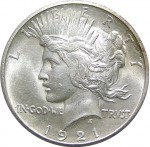 If you have not read “Hobby Must Fill the ‘Empty Chair’” that Michael S. Turini wrote a few weeks ago, then click here to read it first. Go ahead, I’ll wait.
If you have not read “Hobby Must Fill the ‘Empty Chair’” that Michael S. Turini wrote a few weeks ago, then click here to read it first. Go ahead, I’ll wait.
How do we fill the empty chair?
After years of growth spurned by the 50 State Quarters program, the hobby seems to have plateaued at levels lower than expected. Explanations for the slowing in the hobby’s growth range from the downturn in the economy through the downturn in confidence of the products being produced by the U.S. Mint.
I think Michael Turini stumbled on the problem: those of us most interested are getting old.
Not only are we getting old, but we are not doing what it takes to make numismatics inviting to younger members.
We seem to do pretty well in attracting young numismatists (YN), those under 18 years old. In fact, there are programs that actively recruit YNs for the hobby. But we are not doing enough. Not only are there no programs to keep YNs interested after they stop being YNs, there is a real lack of diversity in the hobby.
During my recent trip to Orlando for the 2014 FUN Show, I noticed that there were an increased number of women than I have seen at other shows. I also noticed that other minorities were attracted to the show. Seeing this was great, but how can it be spread to more areas of the hobby?
Numismatics can be a fascinating look at our history. The money that was used reflects the economy of the time which can tell a great story. What can the Morgan dollar teach us about the history of silver, the economy, and the politics of the time that could interest someone? Would learning about the ‘Crime of ’73’ make people think differently about the impact of politics on our economy?

“History Instructing Youth” Educational Series $1 Silver Certificate, Series 1898,
Our thoughts may also be too old.
There are great stories in other areas of numismatics beyond coins and currency. So-called dollars, tokens and medals the size of a dollar coin, were struck to commemorate something, some event, dedication, or anything of significance. So-called dollars tell stories that coin cannot and yet does not get the same attention in the numismatic press as coins.
If you are looking for new numismatic areas to explore or to use as a source to educate someone about history using numismatics, what about items like trade tokens or tax tokens? Trade and tax tokens were local currencies used to build business. In many ways, trade tokens could be considered coupons before someone issued paper coupons!
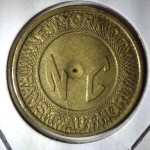
New York City Type 2 Subway Token error. It’s missing the punched out “Y”
In Canada, there are collectors who collect the interesting coupons from a particular tire company.
I know a European-based collector who collects communion medals from a particular region because it traces the history of Catholicism in the area where his family has lived for centuries.
You can even collect the coins of the country where your ancestors or other members of your family are from. I became interested in Canadian coins since my wife’s family is from Canada. Now I am looking at the large cents produced during Queen Victoria’s reign which are affectionately called ‘Vickie Cents.’
Numismatics does not have to be about plugging coins into the holes of a folder or album. It does not have to be about buying coins encased in plastic holders with high numbers or extra symbols. Use numismatics to learn about your past. You can learn more about yourself by understanding your past and what better way to understand your ancestral past than to collect something from that era.
Go collect something new and make sure you tell people about your finds. Tell someone the interesting stories of the past using numismatics as the prop. Make sure you tell them they can have fun with this, as well. Then invite them to your next club meeting and make sure someone is there to talk about their finds and history.
It is only when we can move beyond the cold metal and paper to make the stories interesting can we think about filling all of the empty chairs in the room.
Nov 20, 2013 | advice, coin design, commemorative, legislative, policy, US Mint
As a comment on my post about the selection design for my 2014 Baseball Hall of Fame Commemorative coin a reader commented with a simple question: Can you offer a suggestion as to who I can approach to offer an idea for a commemorative dollar?
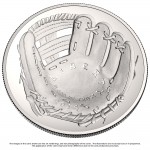
National Baseball Hall of Fame Commemorative was introduced by Rep. Richard Hanna (R-NY) whose district includes Cooperstown, NY
While I cannot fix the fractious nature of congress, I can offer suggestions as to how to get a commemorative coin recognized as a good idea.
As you read this post, let me remind you that former German Chancellor Otto von Bismarck once said, “Laws are like sausages, it is better not to see them being made.” What follows is a look into what it takes to make the sausage in order to propose a commemorative coin and have it become law.
First, rather than starting with congress talk with organizations in the area of interest. After all, commemorative coin programs are fundraising vehicles for the organizations. It helps congress know who will receive the money. In this case, my correspondent wants to see a commemorative coin to be issued in 2017 commemorate the 50th anniversary of the first ever heart transplant.
“My hope is to get more people aware of the need of people to sign up for the donor list to make more organs available,” my correspondent writes. “A donor sign up card could be included with each order. Proceeds could fund awareness program….”
The problem is that this is a good and noble idea but the first question a congress person would ask is what organization would receive the money? Unfortunately, congress is not into creative thinking and would like to know who could receive the money, how the money would be used, and what guarantees that the money earned from the commemorative program would be used for its intended purposes.
Do not expect the representative to do all of the work. In fact, do not expect the congress person to do much of the work until the bill is written and submitted. Even though congress will be in session fewer hours this year than in recent recorded memory, the members will tell you they are too busy to work on this issue. The nature of modern politics is that unless you are going to cut them, the party, their political action committee, or one of their other campaign committees a check, your chance for success is diminished.
However, you can cut through the fog of politics by working with a credible non-profit organization—or a coalition of non-profit organizations—with your interest.

I’m just a bill
Yes, I’m only a bill
And I’m sitting here on Capitol Hill
When contacting these people, I would have an elevator-speech ready. An elevator speech is one that pitches your idea in the time it would take to ride an elevator. In other words, keep it short and to the point. Make sure your pitch includes something compelling to want them ask for more information and make sure you anticipate any questions.
The nice part about partnering with the AHA is that they are very experienced with legislative affairs. I have no doubt that they either have a full-time lobbyist on staff or have hired a lobbying firm to represent their interests before congress. This is one area where you do not have to answer questions. However you should know a little about commemorative coin bills that congress has considered. These issues are as follows:
Q: After a commemorative coin bill is introduced, which committee will it be assigned?
Q: How does the organization make money from a commemorative coin?
A: Congress sets a surcharge over and above the cost to produce the coin that will be given to the sponsoring organization. Usually, the surcharges are $35 for gold coins, $10 for silver dollars, and $5 for clad 50-cent coins.
Q: Are limits set for the number of coins sold?
A: There are no pre-set limits unless written into the law. Usually, congress has set the limits to be not more than 100,000 $5 gold coins, 500,000 $1 silver coins, and 750,000 50-cent clad coins. The number of uncirculated versus proof issues is determined by the
U.S. Mint as long as they remain within these limits. Coins are produced and sold by the U.S. Mint only during the year of issue.
Q: Who designs the coins?
Q: How do we request that heart health and transplant awareness be inserted into the coins with the Certificate of Authenticity?
A: Make sure that the information is added to the law. Unless the sponsoring organization can compel the U.S. Mint to add it, you are better off making sure the law requires that the U.S. Mint does this.
Q: Can you give me an example of how one of these bills is written?
A: Most of the time, when you read the bills submitted to congress, you will see text that calls for editing of the law, which is called the United States Code (U.S.C.). It may say to strike words, replace words, add paragraphs, add sections, and all sorts of other editing that does not make sense unless you know what the U.S.C. says when the bill was written.
Since most commemorative coin bills are additions to the law, they are usually added to Title 31, Section 5112 of the United States Code (31 U.S.C. § 5112). Many times, the bill does not mention where the new law will be inserted when it is introduced. It will be corrected before passage.
If you want to provide the member of congress with the text of a bill, which many times is helpful, you may want to use something that has already been introduced as an example to write your own text. Two good examples are as follows:
When visiting the website, look on the right side in the lower half for the link marked “Read Bill Text.”
Both bills specify gold, silver, and clad coins. Your proposal does not have to include all three. In fact, to raise awareness, you might want to consider just a silver dollar and a clad half-dollar.
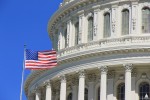
Too bad there’s so much dysfunction in such a beautiful building.
Once you convince a member of congress to submit the bill and get the member’s support, a professional legislative affairs person would know how to convince other members to sign up as co-sponsors. While having a lot of co-sponsors does not guarantee success, it helps with the bill’s awareness and make it more attractive to pass.
There are other political maneuvers that can be used to have the bill passed, such as convincing a member to bring up the bill under a procedure called “suspension of the rules.” In the House of Representatives, a bill brought to a floor vote under the suspension of the rules are usually non-controversial measures that have no objections—or no objections that would be voiced on the floor. The bill would then pass by unanimous consent or a voice vote.
The procedure is similar in the Senate.
Once the bill passes one chamber, it is sent to the other for it to work on passage.

House of Representatives
While the bill is in congress it does not mean you have to sit on your hands and wait. One of the best things you can do is to tell your friends, relatives, and anyone else who will listen to call or email their representative to support the bill. If they are not a co-sponsor, tell their staff that they member should be and why. If they are a co-sponsor, thank them for their support and ask if they could get other members signed on as co-sponsors. If you can find people whose representatives are a member of the House Financial Services Committee or the Senate Banking Committee, then they should modify their support by saying to please help get the bill passed through the committee.

The World’s Most Deliberative Body, the United States Senate
But that does not mean to stop your efforts. Citizen lobbying efforts in the Senate are doubled because each state has two senators. Make sure you and your supporters contact both of your senators. Remember, it is your right as a citizen to meet with your representatives and this includes senators. You can make an appointment to let your senators know how your feel. If your senator is a member of the Senate Banking Committee, then they should be asked to help move the bill out of committee and to the floor for a vote.
The work is not done until the bill is passed or congress is adjourned for the last time on January 2, 2015. Bills not acted upon when congress adjourns for the last time in the session will be considered to have “died in committee.” If the bill dies in committee, you can do this all over again and try to convince a member of congress to submit the bill in the 114th congress that would open its session at noon on January 3, 2015.
If the bill passes both chambers it is likely it will be signed by the president. As far as I know there has never been a commemorative coin bill to have been vetoed by any president.
Although there are a lot of good ideas, many of them are not properly introduced to congress. The few that do make it do not receive enough support to move beyond introduction. Even fewer are passed by one chamber and not both. Those that make it past congress to the president’s desk had some effort behind them besides being just a good idea. After all, with only two commemorative coin programs allowed per year, congress has to be convinced to believe your commemorative idea is better than another for that same year.
Sausage anyone?
Baseball Hall of Fame Commemorative coin courtesy of the
U.S. Mint.
Images of congress and the capitol courtesy of the
Architect of the Capitol.
Image from School House Rock’s “I’m Just a Bill” can be found all over the interwebs.



 Those who follow my
Those who follow my 











 Over the weekend I attended an estate auction that included coins for sale. While my new business venture concentrates on all vintage collectibles, I am still a collector and continue to look for those interesting items and the good coins to add to my collection. As I was looking over the lots I noticed one had several blue folders of Lincoln cents. The collector in me could not resist and I picked up the folders and started looking.
Over the weekend I attended an estate auction that included coins for sale. While my new business venture concentrates on all vintage collectibles, I am still a collector and continue to look for those interesting items and the good coins to add to my collection. As I was looking over the lots I noticed one had several blue folders of Lincoln cents. The collector in me could not resist and I picked up the folders and started looking.



 While all this seems simple to me, I have been in this industry for over 30 years and am used to the complication. The problem with email is that it was developed as a way for researched to communicate by plain text across the Arpanet, the forerunner of the Internet. Essentially, email is a text-based service that has been extended in so many ways that it has created a complicated series of standards that requires a degree in computer science to analyze.
While all this seems simple to me, I have been in this industry for over 30 years and am used to the complication. The problem with email is that it was developed as a way for researched to communicate by plain text across the Arpanet, the forerunner of the Internet. Essentially, email is a text-based service that has been extended in so many ways that it has created a complicated series of standards that requires a degree in computer science to analyze.

 If you have not read “
If you have not read “






